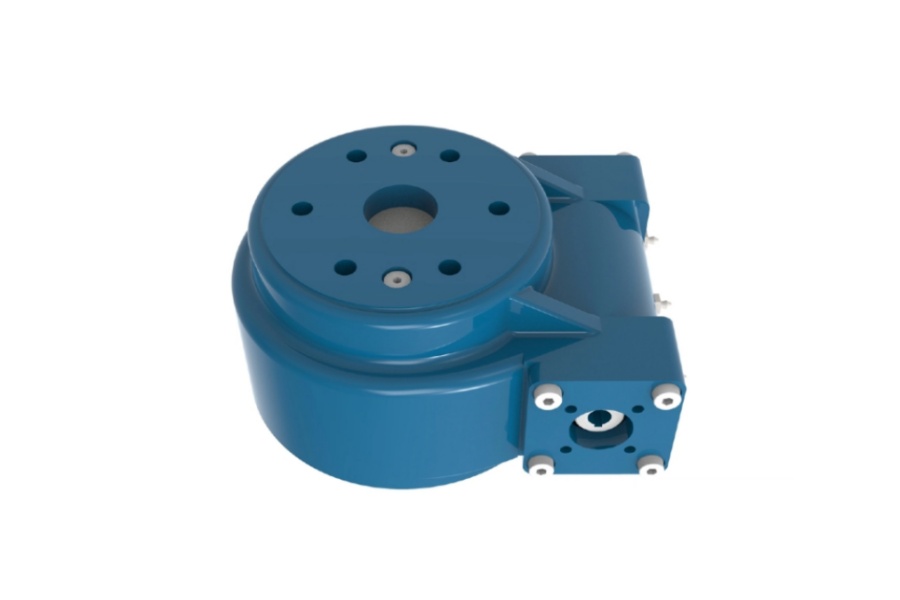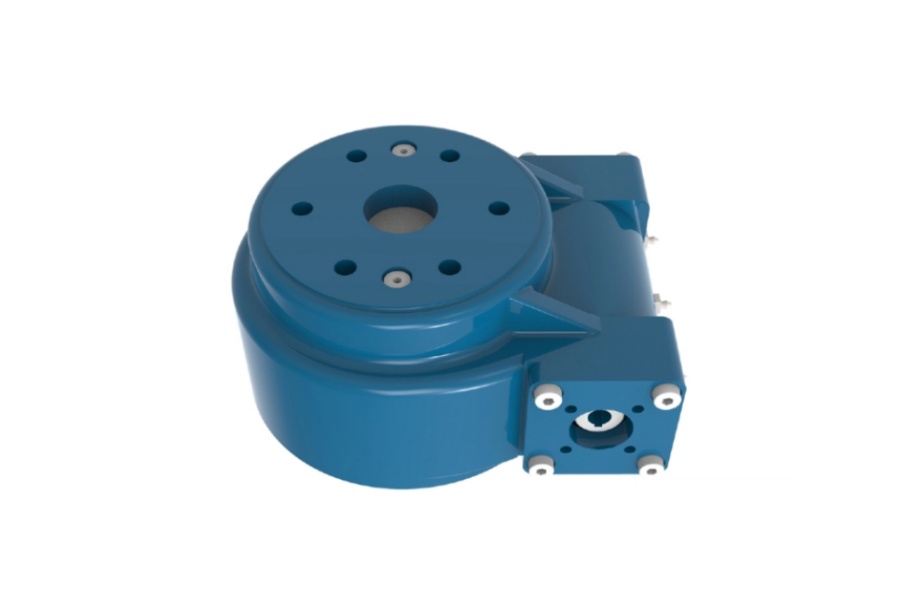
Slew Drive Abnormal Noise Causes and Solutions
What is Slew Drive
Slew Drive is an integrated mechanical assembly that combines a slewing bearing with a worm gear or other drive mechanism to facilitate precise rotational movement under high load conditions. This compact system is engineered to handle significant axial, radial, and moment loads simultaneously while converting input power from hydraulic or electric motors into controlled output rotation. The complete integration of components within a sealed housing provides structural rigidity and space efficiency that cannot be achieved with separate components. Proper lubrication and precise meshing of gear teeth are essential for silent operation and smooth performance. When abnormal noises occur, they typically indicate that something has disrupted this precision, whether it's related to wear, contamination, or improper operation, making timely diagnosis and intervention crucial for maintaining system reliability.

Reasons for Slew Drive Abnormal Noise and Solutions
Abnormal noise in a slew drive is often the first indicator of developing problems that require attention. These sounds can range from grinding and knocking to whining or rattling, each potentially signaling different issues that left unaddressed can lead to catastrophic failure and expensive downtime.
Causes:
Overloaded operation: Exceeding the drive's rated capacity creates excessive stress on gear teeth and bearing components. This overload forces metal-to-metal contact beyond design parameters, generating grinding noises, increased friction, and accelerated wear that manifests as loud operational noises.
Unbalanced working load: Irregular or unevenly distributed loads create variable stress points within the drive system. This imbalance causes irregular meshing of gear teeth and uneven bearing load distribution, resulting in cyclic knocking or rattling sounds that correspond to the rotation pattern.
Deteriorated lubricant: Over time, lubricating oil breaks down, loses its viscosity, and becomes contaminated with metal particles and debris. This degradation reduces its ability to form protective film between moving components, leading to increased metal-on-metal contact and a characteristic grinding or whining noise during operation.
Gear tooth wear or manufacturing defects: Worn gear teeth develop pitting, scoring, or uneven wear patterns that disrupt smooth meshing. Manufacturing imperfections such as improper tooth profile or surface roughness create similar issues, both resulting in repetitive knocking or grinding sounds with each revolution.
Incorrect bearing clearance: Excessive bearing clearance allows rolling elements to move uncontrollably within the raceway, creating rattling or knocking noises. Insufficient clearance causes preload, generating constant friction and high-pitched whining sounds along with increased operating temperatures.
Foreign particles in gear mesh: Contamination by dirt, metal chips, or other debris in the gear housing becomes trapped between meshing teeth. These particles create irregular interference during rotation, producing sharp cracking or grinding noises with each occurrence and potentially causing permanent damage to tooth surfaces.
Solutions:
Verify operating conditions: Conduct thorough inspection of actual operating loads to ensure they remain within manufacturer's specified limits. Implement regular monitoring procedures to prevent overload situations and consider upgrading to a higher capacity unit if applications consistently approach maximum ratings.
Balance load distribution: Review load attachment and distribution methods to ensure even force application across the drive system. Implement proper rigging techniques and consider using load balancing equipment to eliminate uneven stress points that cause noise and premature wear.
Establish regular lubrication maintenance: Develop and implement a strict lubrication schedule based on operating hours and environmental conditions. Completely drain old lubricant, flush the system when contamination is present, and refill with fresh, high-quality oil that meets manufacturer's specifications for viscosity and performance characteristics.
Inspect and replace worn components: Perform regular visual inspections and vibration analysis to detect early signs of gear wear. Replace worn or damaged gear sets with precision-matched components that meet or exceed original equipment specifications, ensuring proper run-in procedures are followed after replacement.
Adjust bearing clearance: Measure existing bearing clearance using appropriate instrumentation and adjust to manufacturer's specified tolerances. For non-adjustable bearings, replacement with properly sized components is necessary to restore optimal operational clearance and eliminate noise issues.
Implement contamination control: Maintain effective sealing systems and conduct regular housing inspections to prevent ingress of contaminants. Establish clean procedures for lubrication maintenance and component replacement to ensure no foreign particles enter the system during servicing operations.
Characteristics of Slew Drive
Slew drives possess several distinctive characteristics that make them indispensable for heavy-duty rotational applications. Their most notable feature is their integrated design, which combines multiple components into a single compact unit, providing significant space savings and structural simplicity compared to traditional separate systems. They deliver exceptional load-handling capability, simultaneously managing axial, radial, and moment loads through robust construction and precision-engineered components. The self-locking capability inherent in many worm gear designs provides built-in safety by preventing back-driving and maintaining position without additional braking systems. Slew drives offer precise positional control, enabling accurate rotational positioning and smooth movement even under substantial load conditions. Their durability is enhanced through the use of high-strength materials, advanced heat treatment processes, and protective sealing systems that ensure reliable performance in demanding environments. The modular design approach facilitates easier installation and maintenance, with standardized mounting interfaces and accessible service points that simplify integration and upkeep.
Applications of Slew Drive
The unique combination of strength, precision, and compactness enables slew drives to serve critical functions across numerous industries. In renewable energy applications, they form the core component of solar tracking systems, precisely orienting photovoltaic panels to maximize energy capture throughout the day, and serve in wind turbines for pitch and yaw control mechanisms. Construction equipment extensively utilizes slew drives in excavators, cranes, and aerial work platforms, where they provide the rotational capability for booms, platforms, and lifting mechanisms. Material handling equipment incorporates these drives in rotary conveyors, stackers, and manipulators that require controlled rotation under load. Industrial automation systems employ slew drives in robotic welding cells, indexing tables, and automated assembly lines where precise rotational positioning is essential. The aerospace and defense sectors utilize them in radar systems, satellite communication antennas, and weapon platforms that require accurate positioning and stability. Even medical equipment manufacturers incorporate precision slew drives in advanced imaging systems like CT and MRI scanners where smooth, reliable rotation is critical.
Factors Influencing the Price of Slew Drive
The cost of slew drives is determined by numerous technical and commercial factors that reflect their complexity and performance capabilities. The primary cost driver is the size and load capacity, with larger units designed for higher loads commanding significantly higher prices due to increased material requirements and manufacturing complexity. The choice of materials affects both performance and cost, with high-grade alloy steels, specialized coatings, and advanced heat treatment processes adding value but increasing manufacturing expenses. Manufacturing precision represents another significant factor, as precision-ground gear teeth, honed bearing surfaces, and exacting tolerance control require advanced machinery and skilled labor, all contributing to higher production costs. The type and complexity of the drive mechanism influence price, with standard worm gear configurations generally being more economical than planetary or hybrid systems that offer higher efficiency or special capabilities. Additional features such as integrated motors, brakes, sensors, or special sealing systems designed for extreme environments add functionality but also increase the overall cost. Finally, brand reputation, certification requirements, warranty coverage, and after-sales support services contribute to the total cost of ownership, with established manufacturers like LYRADRIVE typically commanding premium prices based on proven reliability and comprehensive technical support.
Supplier of Slew Drive
For professionals seeking reliable slew drive solutions, LYRADRIVE stands as a reputable manufacturer and global supplier of high-performance drive systems. The company specializes in the design and production of comprehensive slew drive and slewing bearing solutions that meet rigorous application requirements across various industries. LYRADRIVE maintains commitment to quality through advanced manufacturing processes, stringent quality control measures, and continuous product development. Their product range includes both standard and customized solutions designed to address specific load capacity, environmental condition, and integration requirements. The company provides technical support and engineering expertise to help customers select optimal solutions for their applications. By focusing on reliability, performance, and customer satisfaction, LYRADRIVE has established itself as a trusted partner for businesses that depend on precision rotational drive technology.



